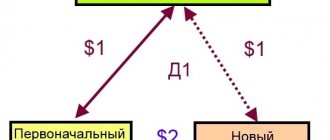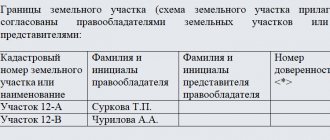Example of an easement
In this example, the company that owns the water supply system enters into an easement with the owner of the site for the possibility of repairing underground communications in the event of an accident
. The intended purpose of the land plot is not only a restriction for its owner (the obligation to exploit the land for certain needs), but also the right to use the territory according to its assigned categories. An easement agreement is one of the legislative instruments that protects this right when its implementation requires access to a neighboring land plot.
Essence and content
The essence of an easement is to provide a limited or unlimited number of persons with the opportunity to:
- drive or pass through private property;
- transport special equipment (for laying utility networks or construction/reconstruction);
- use land resources (pastures, water utilities, communications).
The establishment of a land easement is possible only when there is no other way to carry out specific work or meet the needs of a neighboring plot (access to which is blocked). Parties to the agreement:
- The initiator is a user of someone else's territory, called the authorized person. It can be the legal owner of the land plot or its user (on the basis of an agreement of indefinite/free use, lifelong inheritance, lease).
- The owner of the encumbered land is the obligated party.
Registration
For individuals
State registration of easements is carried out in the Unified State Register of Rights on the basis of an application from the owner of real estate or the person in whose favor the easement is established, if the latter has an easement agreement.
The registration procedure is simple and boils down to providing the Unified State Register with information about the easement being registered and the participants receiving certificates of successful registration.
To register, the applicant must provide :
- registration application;
- a document indicating the existence of an easement (a written agreement between the land owner and the applicant, a copy of a court decision or an order from representatives of local authorities);
- identification document of the applicant;
- information about the land plot in respect of which the easement is being introduced (this is required only if it concerns only part of the territory. If its effect extends to the entire plot, the provision of relevant documents is not required);
- government payment receipt registration fees: for individuals - 1000 rubles, for legal entities - 4000 rubles. You can find out how much the easement will cost here;
- other documents required for registration.
For legal entities
How is state registration of an easement for legal entities carried out? For legal entities related to the easement, the list of documents required to submit is similar to the list for individuals, plus the following is also added to it:
- constituent documents for the relevant legal entities participating in the establishment of the easement;
- documents confirming the rights of representatives of legal entities to represent them.
The exact list of all documents required to provide for each specific case, taking into account possible features, will be different and is regulated on the basis of the Russian Federation Regulations dated February 18, 1998. No. 219.
Both the land owner himself and other persons involved in the registration of the easement act as an applicant and
Registration based on a submitted application from the person in whose interests the easement was created, or other persons, becomes possible in the following cases:
- availability of a written agreement with the owner of the site for registration;
- when the basis for obtaining special rights to land is a court decision;
- when, when establishing special rights to use land, the interests of the public are pursued and registration is carried out by decision of local authorities (all documents are provided by territorial authorities).
When and why is easement law implemented?
Establishing an easement on a land plot has one goal - to ensure the possibility of normal exploitation of the territory, access to which is difficult. Sometimes (a public contract) it is about the use of limited resources located on private territory.
The specific purposes of concluding an agreement may be:
- the need to build on a land plot where equipment (or a team of construction workers) can only get through a neighbor;
- travel/passage to the site through the neighboring territory (in the absence of direct access to it);
- the need to lay communications (connection through a neighbor to water, heating, electricity, gasification);
- repair work on the established border between areas and much more.
An easement agreement is a limited encumbrance on land. By providing a “normalized” right to use someone else’s territory, it does not limit the owner of this territory in property rights.
Grounds for cancellation of easement
Termination of the right to use is possible only if there are legal grounds. This happens with the termination of an already executed contract. More often this procedure is carried out by agreement of both parties. An act of cancellation is drawn up, and after that the registration of the easement on the land plot is cancelled.
But it is better for the parties to prescribe the conditions for termination: as soon as the circumstances for its conclusion disappear, the easement agreement for the land plot of the established form will be canceled. That is, there is no need to go to court , you can simply register the cancellation.
If termination is necessary for only one party, then it should apply to the territorial court. But this authority approves the decision only if there are legal grounds for it. Based on this, you should collect evidence in advance to support your position.
In order to send an application to the court, you should collect the following list of documents:
- agreement,
- statement of claim,
- extract from the Unified State Register of Rights of Use,
- evidence of termination of circumstances,
- passport of the person who declares the termination.
Attention! The applicant should know that in order for the court to approve the decision, strong evidence is needed, and sometimes the testimony of witnesses.
Types of contracts
The main classification of land easements is determined by the Land Code of the Russian Federation (Article 23) and divides contracts into public and private.
A private treaty is the right for one neighbor to use the land of another. The encumbrance can be imposed both on a limited area of the territory and on the entire plot within its cadastral boundaries. The basis for establishing a private easement may be a peace agreement or a court decision.
A public document is the right to use owned land for an unlimited number of persons in the interests of the state, population, and local administration bodies. The establishment of a public easement always carries social content.
Other characteristics divide contracts into fixed-term and indefinite, partial and established for the entire land plot.
Notes[ | ]
- ↑ 1 2 Romanova E. N., Zelik V. A.
Legal nature of public easements // Society and law.. - 2012. - T. 40, No. 3. - ISSN 1727-4125. - Article 274 Civil Code of the Russian Federation (part one) dated November 30, 1994 No. 51-FZ (as amended on March 28, 2017)
- Land Code of the Russian Federation dated October 25, 2001 No. 136-FZ (as amended on July 3, 2016) (as amended and supplemented, entered into force on January 1, 2017)
- Federal Law of July 21, 1997 N 122-FZ (as amended on July 3, 2016) “On state registration of rights to real estate and transactions with it” Art. 1 “restrictions (encumbrances) - the presence of conditions, prohibitions established by law or authorized bodies in the manner prescribed by law that constrain the right holder in the exercise of ownership or other real rights to a specific object of real estate (easement..."
- Bondarenko V.V.
Comparative legal review of the legal regulation of easement relations in foreign countries // Legal science: history and modernity. - 2012. - No. 10. - P. 69-72. — ISSN 2218-7170. - Arsnaliev M.A.
Easements in modern civil legal systems of foreign countries // The Power of Law. - 2013. - T. 16, No. 4. - P. 90-99. — ISSN 2079—0295.
The procedure for establishing and registering an easement on a land plot
The legal framework consists of the Civil and Land Codes, 122-FZ and a number of other laws (on agricultural management, livestock farming, and the use of subsoil). What determines the complex procedure for establishing an easement .
GeoStroyProekt LLC has mastered all the subtleties and nuances of this process. We constantly monitor changes in legislation, so we can provide competent assistance or protection against land encumbrances where there is no objective need for it.
The basis of the procedure is a written agreement between the obligated party and the authorized user. Its form is the same for all regions, including the Penza region . There are a number of parameters that must be reflected in the contract, confirming its validity:
- Name.
- Details of the parties.
- Information about the land plot on which the boundaries of the encumbrance are established.
- Reasons, goals, grounds for encumbrance.
- Access rights boundaries.
- Rent volume.
Payment
The last point is worth dwelling on separately. Thus, the Civil Code of the Russian Federation defines a clear obligation of the authorized party to pay a fee for the use of an easement (easement right).
Its size is set individually and must be justified. The specific rate is a dependent value, calculated taking into account the intensity of use of the site, the nature of its use, the consequences that such use may lead to (passage of heavy equipment, regular passage of personal vehicles, if this is a travel easement ).
The user fee may include:
- expenses of the obligated party for the formation of conditions for the implementation of easement rights (clearing the territory, building roads);
- the cost of organizing a security checkpoint;
- repair of utility networks that will be used by authorized persons.
The fee can be paid one-time or regularly. The first option is usually used for fixed-term contracts, the second involves a clear fixation in the agreement of the terms, procedure, size, and frequency of payment cost .
In some cases, the establishment of an easement on a site is possible free of charge. Participants can reach such a solution through peaceful negotiations.
Sample easement agreement
How to draw up an easement agreement?
The agreement gains strength not from the moment of signing, but from the date of registration of the easement in the Unified State Register (USPR). This is clarified by the norms of 122-FZ. You can register the document yourself or seek help from GeoStroyProekt specialists. In the latter case, you will only need:
- 2 applications (from each owner);
- passports of representatives of the parties (for a legal entity - extract from the Unified State Register of Legal Entities);
- receipt of payment of the fee (for 2020 the fee is 1000 rubles for individuals, 4000 for enterprises/companies/organizations);
- signed contract.
When registering a public easement, decisions of municipal/state authorities are additionally required. If the encumbrance is imposed by a court decision, it must also be provided. When access is provided to part of the site, registration of the agreement is carried out in the presence of an extract from the cadastre for the encumbered site with the intended boundaries of open access.
At the exit (if you decide to order a support service from GeoStroyProekt), the owner of the encumbered plot will receive a notice of the imposition of an encumbrance. The initiator of the process of implementing the easement right - a certificate of registration of his agreement.
Validity
The validity period depends on the period for which the easement is registered. Here is a brief classification of easements on a land plot:
- A temporary easement is established for a specific time. For example, documents are issued for 1 year.
- Perpetual has no expiration date. Basically this means a long period of time.
Most often, perpetual varieties are installed. But first of all, you need to think about the timing.
Termination of an easement is possible in the following cases:
- at the request of the owner of the plot on which the easement is established;
- the reasons for which this right was established have disappeared;
- it is impossible to use the site for its intended purpose.
This means that the term of the easement directly depends on when the agreement is violated.
Read about preparing a cadastral plan for a land plot. Where can I see the cadastral number of a land plot? Information here.
How much does land surveying cost? Details in this article.
Judicial establishment of easement
Being savvy in the legal nuances associated with land use processes, our experts always strive to come to an amicable agreement on establishing an easement of a land plot between neighbors. But in the absence of an opportunity to reach an agreement, we will competently represent you in court.
Only the owner of land to which access is restricted can file a claim to establish an easement The defendant under the law is the owner of the land on which the encumbrance is supposed to be imposed. Grounds for claim:
- The presence of objective evidence of the need to gain access to one’s site through someone else’s. The responsibility for collecting evidence and presenting it in court rests with the defendant (his representative).
- The property that needs to be encumbered is owned and has undergone cadastral registration.
If the outcome of the case is positive (a court decision to conclude an agreement), the establishment of an easement of the land plot is “tied” to the real estate, and not to its owner, according to Art. 275 Civil Code. That is, when the encumbered plot is transferred into the possession of another person, the neighbor’s right to use it is preserved.
In the absence of the grounds that determined the execution of the easement , the obligated party may demand the removal of the encumbrance. Termination of the easement right is also possible by mutual consent of the parties to the agreement.
What is an easement?
Many land owners have heard of this concept, but have no idea what it is or why it is needed. The document confirms the right of one person to use the real estate of another , but only to a limited extent, since it is someone else’s property. The right of easement is the right to use real estate, but within strict limits.
Thus, the property of one person cannot be used by another person permanently, that is, real estate is not for sale. An easement can be established by mutual agreement of the parties or based on a court decision.
A limited right of use may be required in a variety of cases, for example:
- There is a source of water on someone else's property that the owners of neighboring lands want to use.
- There is a road on someone else's land, and it is impossible for the second person, who is the owner of the neighboring plot of land, to leave his own plot. In this case, you can also obtain the right to use the road.
Important! Only a person who does not have the opportunity to exercise his own rights without consent to exploit someone else’s land can apply for registration of rights.
Where to order an easement in Penza?
provides comprehensive support for forced or voluntary registration of land easements in Penza and the region. Already at the first consultation, we will help you determine the prospects for a successful outcome of the case and outline an action plan and an estimate of current expenses. Initial legal consultation is provided free of charge.
Depending on individual circumstances, our specialists will draw up for you an effective plan of solutions for establishing a private easement in Penza :
- We will help you prepare all the necessary documents and fill out application forms without errors.
- We will negotiate with our neighbor. It is easier to achieve a peaceful solution to the problem with us.
- We will draw up a contract correctly. Here you can view or take as a basis a sample of establishing an easement .
- If necessary, we will develop tactics for judicial conduct of the case, protect your interests in court, and collect evidence.
- We will monitor the execution of the court decision.
Feel the care of professionals. We work for your results, reduce the cost of a complex procedure to a reasonable minimum, and work strictly according to the law.
The cost of establishing an easement in Penza
The price for professional participation of GeoStroyProekt is always determined individually. Our lawyers have extensive experience working with easement law. Already at the first consultation you will be able to get an idea of the costs.
As our experience shows, the average cost of comprehensive legal and organizational support for the process starts from 30 thousand rubles. But for a more accurate calculation (the amount may decrease depending on the circumstances), please contact our specialists. You can sign up for a free consultation by phone or email.









